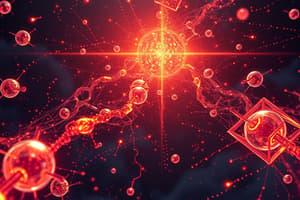Podcast
Questions and Answers
Why is the SN1 mechanism ruled out for haloarenes?
Why is the SN1 mechanism ruled out for haloarenes?
- The phenyl cation formed is not stabilized by resonance. (correct)
- The presence of the aromatic ring hinders the formation of a carbocation.
- The haloarene molecule is too stable to undergo SN1.
- The halogen atom is too strongly bonded to the benzene ring.
Which of the following groups would be expected to increase the reactivity of a haloarene in a nucleophilic aromatic substitution reaction?
Which of the following groups would be expected to increase the reactivity of a haloarene in a nucleophilic aromatic substitution reaction?
- Nitro (-NO2) (correct)
- Methyl (-CH3)
- Methoxy (-OCH3)
- Amino (-NH2)
How does the presence of a nitro group at the ortho or para position affect the reactivity of haloarenes?
How does the presence of a nitro group at the ortho or para position affect the reactivity of haloarenes?
- It makes the reaction proceed through an SN1 mechanism.
- It has no effect on the reactivity.
- It decreases the reactivity by withdrawing electron density from the benzene ring. (correct)
- It increases the reactivity by donating electron density to the benzene ring.
Why does the nitro group at the meta position not significantly affect the reactivity of haloarenes in nucleophilic aromatic substitution?
Why does the nitro group at the meta position not significantly affect the reactivity of haloarenes in nucleophilic aromatic substitution?
What is the main reason why nucleophiles are less likely to approach electron-rich arenes?
What is the main reason why nucleophiles are less likely to approach electron-rich arenes?
What is the mechanism of the reaction converting chlorobenzene to phenol?
What is the mechanism of the reaction converting chlorobenzene to phenol?
Which of the following statements is true about the resonance stabilization of the intermediate carbanion in nucleophilic aromatic substitution reactions?
Which of the following statements is true about the resonance stabilization of the intermediate carbanion in nucleophilic aromatic substitution reactions?
Which of the following statements accurately describes the effect of electron-withdrawing groups on the reactivity of haloarenes in nucleophilic aromatic substitution?
Which of the following statements accurately describes the effect of electron-withdrawing groups on the reactivity of haloarenes in nucleophilic aromatic substitution?
What is the key reason why the nitro group at the meta position does not significantly affect the reactivity of haloarenes in nucleophilic aromatic substitution?
What is the key reason why the nitro group at the meta position does not significantly affect the reactivity of haloarenes in nucleophilic aromatic substitution?
Why is it less likely for an electron-rich nucleophile to approach an electron-rich arene?
Why is it less likely for an electron-rich nucleophile to approach an electron-rich arene?
Study Notes
Electrophilic Substitution Reactions in Haloarenes
- Haloarenes participate in electrophilic reactions typical of benzene, including halogenation, nitration, sulphonation, and Friedel-Crafts reactions.
- Halogen atoms are slightly deactivating but act as ortho- and para-directing groups, leading to further substitution at these positions.
- Resonating structures in halobenzene show increased electron density at ortho- and para-positions, while meta-positions have lower electron density.
- The –I effect from halogen atoms withdraws electrons, causing haloarenes to be less reactive than benzene, making reactions slower and requiring harsher conditions.
Halogenation, Nitration, Sulphonation, and Friedel-Crafts Reaction
- Halogenation involves the introduction of halogens into the benzene ring.
- Nitration adds nitro groups to the ring structure.
- Sulphonation incorporates sulfonic acid groups into the aroma.
- Friedel-Crafts reactions carefully attach acyl or alkyl groups to the aromatic system.
Role of Chlorine in Electrophilic Aromatic Substitution
- Chlorine's dual behavior: electron-withdrawing via inductive effect, yet it releases electrons through resonance, enabling ortho- and para-directing capabilities.
- This positions chlorine uniquely, as it can destabilize some intermediates, yet still promotes substitutions at specific positions.
Substitution Nucleophilic Bimolecular (SN2) and Substitution Nucleophilic Unimolecular (SN1) Reactions
- SN2 reactions favor primary halides due to minimal steric hindrance, making them more reactive than secondary and tertiary halides.
- Rate order for SN2: Primary > Secondary > Tertiary halides.
- SN1 reactions proceed in polar protic solvents and follow first-order kinetics, where the rate depends on just one reactant (e.g., tert-butyl bromide).
- SN1 involves two steps: cleavage of C—Br bond to form a carbocation, followed by nucleophilic attack.
Stability of Phenyl Cation
- Phenyl cation is unstable due to lack of resonance stabilization in haloarenes, ruling out SN1 mechanisms for these compounds.
Interconversion of Chlorobenzene to Phenol
- Chlorobenzene can be transformed into phenol by heating with aqueous sodium hydroxide at high temperatures (623K) and pressures (300 atmospheres).
Influences of the Nitro Group on Reactivity
- An electron-withdrawing nitro group (-NO2) at ortho- and para-positions significantly enhances the reactivity of haloarenes by facilitating nucleophilic attack.
- The negative charge developed by the reaction intermediate is stabilized through resonance when -NO2 is located at ortho- and para-positions.
- Nitro groups at meta-positions do not affect reactivity, as the negative charge can't be stabilized through resonance with the nitro group.
Summary of Mechanisms
- Presence of electron-withdrawing groups can strategically alter reactivity in haloarenes, demonstrating the importance of functional group positioning within aromatic chemistry.
Studying That Suits You
Use AI to generate personalized quizzes and flashcards to suit your learning preferences.
Related Documents
Description
Explore the fascinating world of haloalkanes and haloarenes in this quiz. Focused on electrophilic substitution reactions, this quiz covers key concepts including halogenation and Friedel-Crafts reactions. Test your understanding of how halogen atoms influence reactivity and directionality in substitution.




